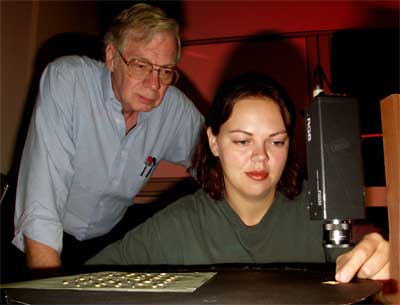Fayetteville, Arkansas
January 26, 2005
A machine inspection system under
development at the University of
Arkansas Division of Agriculture can peer through intact
hulls to inspect individual rice kernels for damage.
“This is primarily of value for rice breeders and
physiologists,” said Dr. Carl Griffis, professor of biological
and agricultural engineering.
“They look for traits like resistance to insects and diseases,”
Griffis said. “Current evaluation techniques require removing
the hulls for visual inspection of the grain. Those kernels,
then, are more difficult to plant to produce the next generation
of a breeding line.”
Building on the machine vision groundwork of former UA engineer
Dr. Yang Tao, Griffis and graduate student Amber Gosnell are
developing a system that can inspect individual rough rice
kernels and separate damaged from undamaged.
“Yang Tao had an idea to make video images of rice kernels
back-lighted with a strong light source,” Griffis said. “He
demonstrated that damage from disease or insects causes
blackened areas on the grains that show up as darkened areas in
the images.”
A computer program processes those images and predicts damage.
Griffis said visual examination of machine-inspected rice shows
a high correlation of accuracy.
“The machine system is predicting damage with better than 80
percent accuracy,” he said. “We’re working on ways to improve
that percentage.”
One means of improving accuracy is to add a second camera.
Gosnell’s research has shown that making two images of each
kernel, one each from top and bottom, increases the accuracy.
Other improvements being added to the system include a device
that can feed individual kernels onto a transport system that
moves them past the cameras one at a time, and a system that
uses a puff of air to move damaged and undamaged kernels into
separate bins. Improved software will permit “point-and-click”
operation of the system.
Dr. Karen Moldenhauer, UA rice breeder, has asked Griffis to
incorporate a means of measuring the dimensions of kernels still
in the hulls. “It’s another measure of rice quality that’s
important to breeders,” Griffis said.
“Breeders can then plant the undamaged rice to make further
selections toward improved varieties,” Griffis said.
Griffis and Gosnell are completing the first year of a
three-year study on the machine inspection system. At the end of
three years, Griffis plans to deliver a fully automated system
to Division of Agriculture scientists at the Rice Research and
Extension Center at Stuttgart.
“We’re standing on the shoulders of Dr. Tao to develop this
system,” Griffis said. “His initial work set the stage for us to
continue it toward a full-scale prototype that will become a
valuable tool in the effort to develop improved rice varieties
for Arkansas producers.”

Dr. Carl Griffis, professor of
biological and agricultural engineering, and
graduate student Amber Gosnell use a video camera to inspect
rice kernels
for damage from insects or disease. The machine inspection
system can detect
damaged kernels without removing the hulls. |